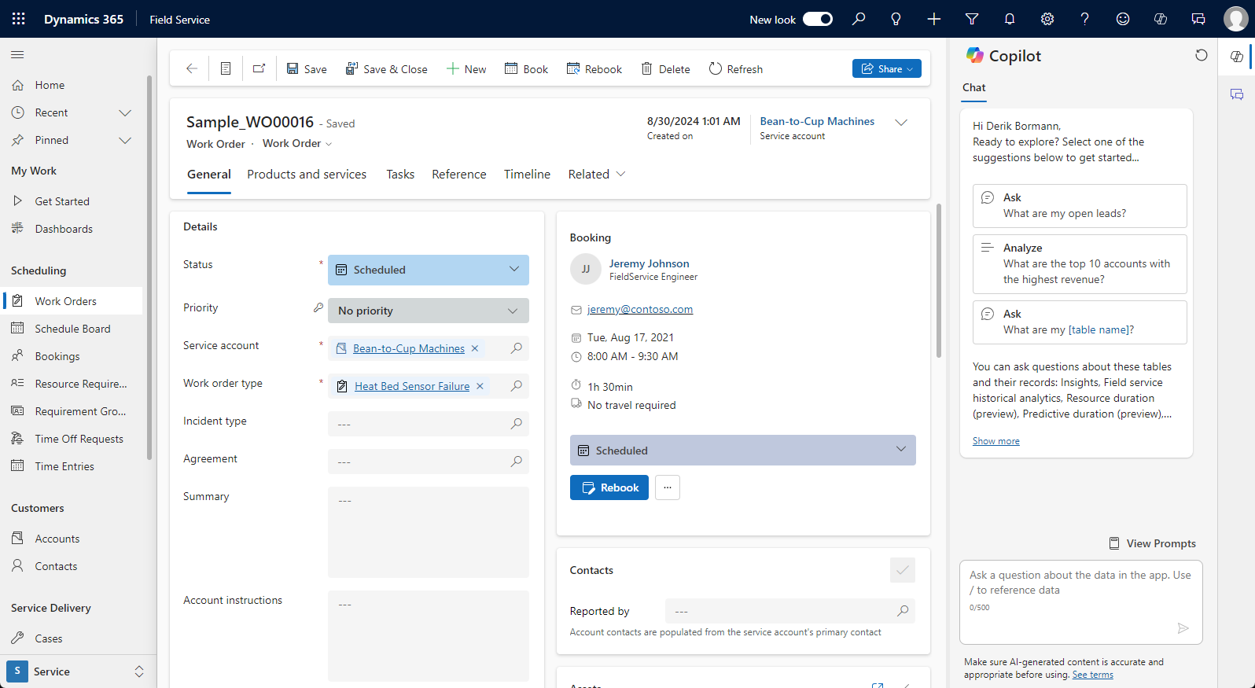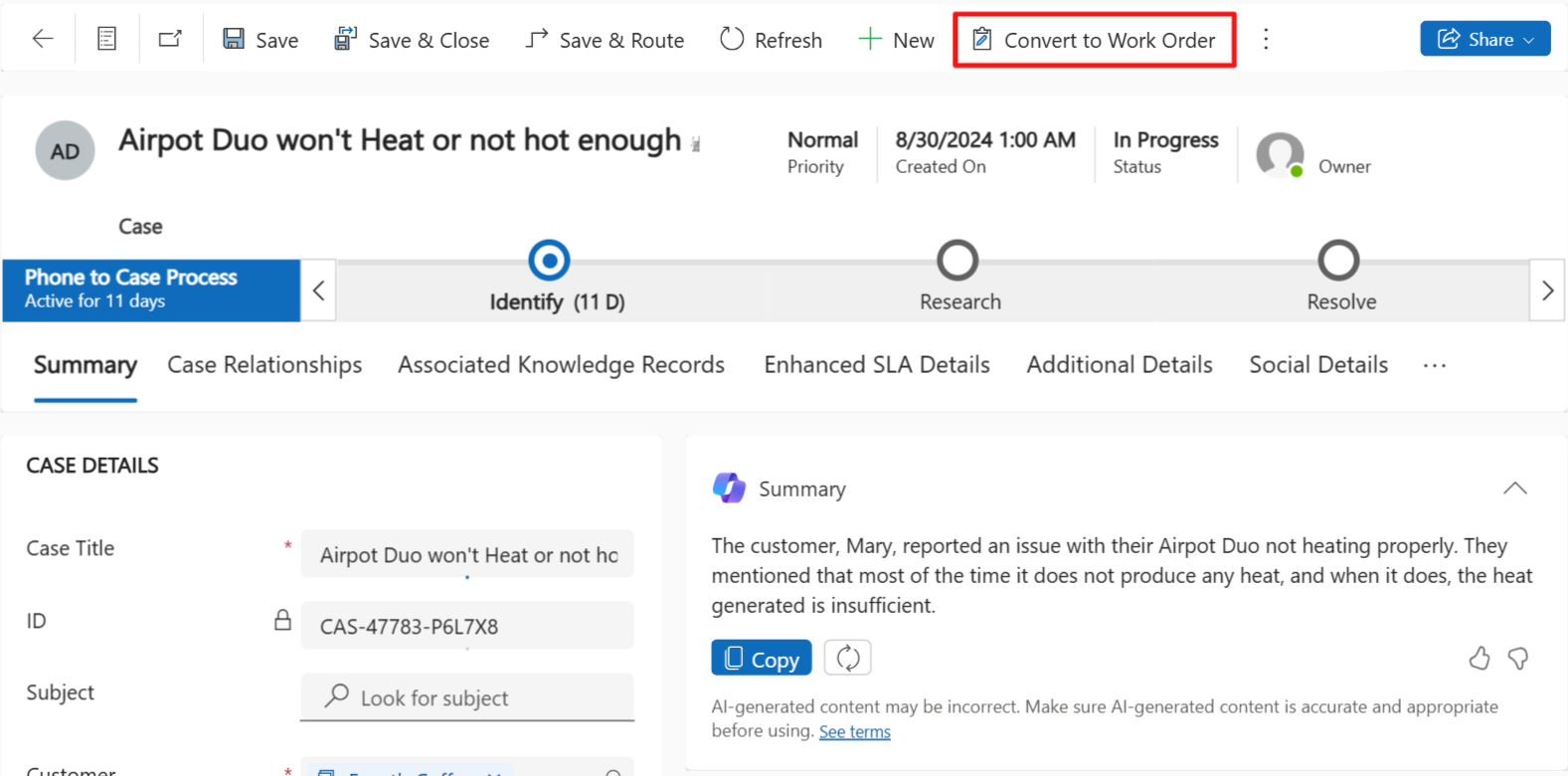Create and define work orders
There are multiple ways to create work orders in Microsoft Dynamics 365 Field Service. This flexibility accommodates the various needs of organizations.
Work orders can be created:
As part of a defined service selling process.
As an escalation for a case that couldn't be resolved remotely.
By a customer manually requesting or scheduling service from a portal.
Automatically, based on a service agreement or schedule.
Manual work order creation
In many instances, work orders are created manually by dispatchers who receive the work order request from customers. A dispatcher can enter relevant information such as customer name, location of service, service preferences, etc.
When manually creating a work order, you need to enter information on several tabs. These include:
General: Contains general overview information about the work order such as the status, customer, type of work order, and pricing information.
Products and Services: Lists all products and services that are included in the work order.
Tasks: Defines any tasks that a technician performs as part of work order.
Reference: Displays any knowledge articles, guides, or media files that have been associated with the work order.
Timeline: Provides access to the record timeline where you can log activities associated with the work order such as phone calls and appointments.
Converting from an opportunity
Many organizations sell service-based items. For example, a store that sells appliances or furniture often has installation services associated with them. Your organization can use the sales capabilities of Dynamics 365 to manage these sales opportunities, especially for longer-running scenarios. To convert an opportunity to a work order, on the opportunity record, select Convert to Work Order. To make sure an opportunity can be converted, you'll first need to define the following.
A work order type: On the Field Service tab of the opportunity, for Work order type, enter a type.
A sales tax code: On the account record of the opportunity, enter a default sales tax code. If the account is tax exempt, note that on the account record as well.
Converting from a case
There will be times when call centers or the help desk are unable to solve cases remotely. In these instances, it might be necessary to dispatch a technician to solve the problem. For example, a customer might have an Internet of Things (IoT)-enabled temperature sensor in a server room. When the temperature sensor triggers an alert, a case is created in Dynamics 365. If the representative working on that case can't resolve it, a technician might be dispatched to run other testing on the sensor.
Like opportunities, cases can be converted to work orders.
To ensure a case can be converted, you'll first need to define the following:
An incident type: On the Field Service tab of the case, (you may need to select the Ellipsis next to Social Details to display the related drop-down menu and access the Field Service option), define the incident type for the case. This ensures that the necessary products, services, and tasks are populated into the work order.
A Price List: For the system to know how to price the products and services, a price list needs to be specified for the work order that will be created. Price Lists can be associated with other records such work order types or with an account record. When a Work Order a case for that account is converted to a work order the Price list will be used.
There are other ways to create work orders. You might consider:
Agreements: Agreements provide the ability to autogenerate work orders on a defined schedule. They're commonly used when organizations have maintenance agreements for specific pieces of equipment. For example, every three months a work order is created to have a technician come out and inspect an MRI machine. When looking to generate work orders from agreements, consider things such as:
What types of agreements will you need?
How often should work orders be generated?
Should they be scheduled as well?
What information is needed such as products, services, tasks, skills, etc.
A scheduling portal: A customer might want to request service or schedule work orders from a portal. Before allowing work order creation from a portal, you should consider the following:
Who will be creating the work orders?
Is the customer simply placing a request and the actual scheduling will be done internally?
Is the customer scheduling the work order?
What information is required to allow this?
Connected Field Service (CFS)/Internet of things (IoT): Because more IoT-enabled devices are in use, organizations are using them to change their service models. Before allowing the creation of work orders from IoT-enabled devices, consider:
What type of devices will be used?
How will those devices be registered?
What information is needed from the devices?
What types of exceptions generate alerts?
What types of alerts will be used to generate work orders?
How will those be captured?

